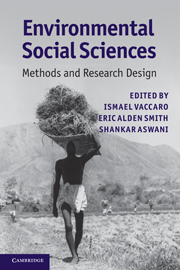Book contents
- Frontmatter
- Contents
- Contributors
- Foreword
- Preface
- 1 Introduction
- 2 People, numbers, and natural resources: demography in environmental research
- 3 Production decisions and time allocation: a guide to data collection
- 4 Analyzing the politics of natural resources: from theories of property rights to institutional analysis and beyond
- 5 Extreme events, tipping points, and vulnerability: methods in the political economy of environment
- 6 Local communities and natural resources: ethnobiology in practice
- 7 Mapping histories: cultural landscapes and walkabout methods
- 8 Metaphors and myths in news reports of an Amazonian “Lost Tribe”: society, environment and literary analysis
- 9 Water decision-makers in a desert city: text analysis and environmental social science
- 10 Linking human and natural systems: social networks, environment, and ecology
- 11 Khat commodity chains in Madagascar: multi-sited ethnography at multiple scales
- 12 Spatiotemporal methodologies in environmental anthropology: geographic information systems, remote sensing, landscape changes, and local knowledge
- 13 Deep time, diachronic change, and the integration of multi-scalar data: archaeological methods for exploring human–environment dynamics
- 14 Comparing trajectories of climate, class, and production: an historical ecology of American yeomen
- 15 Socioecological methods for designing marine conservation programs: a Solomon Islands example
- Index
- References
15 - Socioecological methods for designing marine conservation programs: a Solomon Islands example
Published online by Cambridge University Press: 05 June 2012
- Frontmatter
- Contents
- Contributors
- Foreword
- Preface
- 1 Introduction
- 2 People, numbers, and natural resources: demography in environmental research
- 3 Production decisions and time allocation: a guide to data collection
- 4 Analyzing the politics of natural resources: from theories of property rights to institutional analysis and beyond
- 5 Extreme events, tipping points, and vulnerability: methods in the political economy of environment
- 6 Local communities and natural resources: ethnobiology in practice
- 7 Mapping histories: cultural landscapes and walkabout methods
- 8 Metaphors and myths in news reports of an Amazonian “Lost Tribe”: society, environment and literary analysis
- 9 Water decision-makers in a desert city: text analysis and environmental social science
- 10 Linking human and natural systems: social networks, environment, and ecology
- 11 Khat commodity chains in Madagascar: multi-sited ethnography at multiple scales
- 12 Spatiotemporal methodologies in environmental anthropology: geographic information systems, remote sensing, landscape changes, and local knowledge
- 13 Deep time, diachronic change, and the integration of multi-scalar data: archaeological methods for exploring human–environment dynamics
- 14 Comparing trajectories of climate, class, and production: an historical ecology of American yeomen
- 15 Socioecological methods for designing marine conservation programs: a Solomon Islands example
- Index
- References
Summary
Introduction
This concluding chapter provides an example of how the integration of various social and ecological methods, such as the ones presented in this volume, can shape the formulation of successful public environmental policy. Using marine conservation as an example, I elaborate and delineate various integrated methodological approaches for designing conservation areas such as marine protected areas (MPAs) that can be used by anthropologists and natural scientists alike. I also discuss how social scientists are favorably positioned to design conservation programs that are better tailored to the local context and summarize some ideas about how they can achieve the elusive goal of long-term project sustainability.
Most marine biologists agree that sound scientific data are essential when designing MPAs (e.g., Bergen and Carr 2003). Marine biologists have also widely promoted MPAs as enhancing spawning stock biomass, allowing for larval dispersal and the export of adults to adjacent non-protected areas, maintaining species diversity, preserving habitat, and sustaining ecosystem function (Roberts et al. 2001; Russ and Alcala 1999). Social scientists, however, have been generally critical of marine and fishery scientists for paying too much attention to biodiversity and stock-recruitment models and neglecting the social dimension of human–marine relations when designing and implementing conservation and fishery policies, respectively (Acheson and Wilson 1996; Pollnac, Crawford, and Gorospe 2001).
- Type
- Chapter
- Information
- Environmental Social SciencesMethods and Research Design, pp. 349 - 376Publisher: Cambridge University PressPrint publication year: 2010



